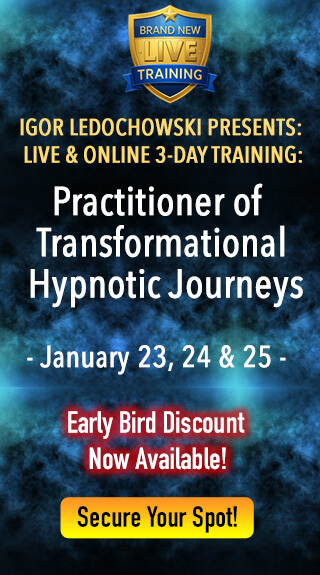
Building rapport is one of the cornerstones of effective hypnosis and communication. As any experienced hypnotist will tell you, establishing a deep and genuine connection with a client can make all the difference in the success of a session. But what exactly does it take to create a connection like that? One of the most powerful, yet often misunderstood, tools in a hypnotist’s repertoire is the technique of matching and mirroring.
While some may dismiss it as a simple tool from NLP (Neuro-Linguistic Programming), when used correctly and naturally, matching and mirroring can lead to powerful subconscious alignment, which will in turn create trust and a powerful feedback loop between the hypnotist and the subject. Here, the process of building hypnotic rapport through matching and mirroring will be explored in detail, indicating why it works, how to use it effectively, and even why forcing it can lead to failure.
What Is Matching And Mirroring?
Matching and mirroring are processes where you subtly replicate another person’s body language, tone of voice, gestures, or even speech patterns. The idea is that whenever an individual subconsciously sees someone else reflecting their behaviors, they’re very likely to feel much more comfortable and aligned with them. The unconscious mind communicates silently, creating rapport without people even realizing it.
However, there’s a common misunderstanding that matching and mirroring mean directly copying every gesture or word that another person uses. This can come off as parroting, which not only feels forced but can also offend the person you’re trying to connect with.
True matching and mirroring happens unconsciously and naturally. When rapport is genuinely established, both individuals fall into sync without consciously trying to match every movement or word.
Why Parroting Doesn’t Work
If matching and mirroring are done incorrectly, it can feel awkward and even disingenuous. This is because parroting is a conscious effort to mimic another person. When the conscious mind takes over a task that should be left to the unconscious, it disrupts the natural flow of rapport.
This leads to what is called the Law of Reverse Effect, which states that the more someone consciously tries to achieve something the unconscious mind should handle, the more likely they are to fail. In simple terms, the harder an individual tries to consciously mirror someone else, the more awkward and unnatural their interaction becomes.
Consider this analogy: imagine a person driving a car, and suddenly, a young child jumps onto their lap and starts yanking the steering wheel. It’s chaotic, dangerous, and not a recipe for safe driving. In the same way, forcing rapport through conscious parroting can make interactions feel out of control and uncomfortable.
How To Naturally Build Hypnotic Rapport Through Matching And Mirroring
So if forcing rapport doesn’t work, how can someone naturally build hypnotic rapport through matching and mirroring? The answer lies in leveraging the unconscious mind. Hypnosis itself is about creating unconscious shifts, so it makes sense that establishing rapport should flow naturally from the unconscious level.
Here’s how to approach it:
- Give the Unconscious Mind Clear Intentions
Before beginning any hypnosis session or conversation, set an unconscious intention to build rapport. Instead of thinking, “I must copy their movements,” a hypnotist can refocus their attention on a broader goal, such as: “I want to create rapport with this person.” This primes their unconscious mind to seek connection without forcing any specific behaviors. - Go First: Enter a Trance-Like State
Rapport doesn’t just come from mimicking actions—it starts from within. By entering a light trance or heightened state of awareness, a hypnotist can prepare themselves to connect more deeply with their client. Trance enhances sensitivity to the feedback they provide and allows your unconscious to naturally sync with theirs. - Create a Feedback Loop
Once rapport begins to build, a feedback loop starts to form. As a subject gives subtle feedback through body language or facial expressions, a hypnotist’s unconscious mind can pick up on these cues and respond. The client, in turn, will respond to their unconscious signals, reinforcing the connection. Over time, this creates a fluid back-and-forth where the process of building hypnotic rapport through matching and mirroring happens effortlessly. - Internalize Positive Relationships
Another way a hypnotist can trigger natural rapport is to think of people they’re already close to: family members, friends, or loved ones. By recalling the way they feel around people they already naturally connect with, they activate those feelings in their current interaction. An approach like this leads to authentic connection, as their unconscious mind begins to mirror the emotional resonance they’ve internalized from past experiences.
The Power Of Subconscious Communication
The beauty of matching and mirroring lies in its natural occurrence when rapport is present. There’s no need to focus on every detail, no need to consciously track every gesture or tone shift. When done correctly, rapport flows from the unconscious mind, making it feel easy and organic.
At its core, building hypnotic rapport through matching and mirroring works because it allows one unconscious mind to communicate with another. When consciously forced, the process becomes stilted and ineffective. But when left to the unconscious, rapport develops naturally, leading to a deeper connection between a hypnotist and their subject.
Practical Application For Hypnotists
For both aspiring and professional hypnotists, mastering the art of matching and mirroring is essential for building trust and ensuring a successful session. Here’s a quick breakdown of the key steps to take:
- Set an intention: Before interacting with a subject, tell your unconscious mind that you aim to build rapport.
- Be present: Enter a state of heightened awareness or light trance, making it easier to pick up on a subject’s unconscious cues.
- Stay open to feedback: Notice any subtle shifts in the subject’s body language and speech patterns, and let your unconscious mind guide the connection process.
- Avoid overthinking: Let go of any pressure to force rapport. When the unconscious mind takes over, matching and mirroring will occur naturally.
- Internalize positive connections: Recall relationships where rapport flows effortlessly, and use that emotional resonance to enhance the connection with your subject.
Final Thoughts On Building Hypnotic Rapport Through Matching And Mirroring
Matching and mirroring are potent techniques for fostering rapport, but they work best when allowed to unfold naturally. By engaging the unconscious mind, hypnotists can foster a deep, authentic connection with their clients, enhancing the effectiveness of every session. Instead of focusing on consciously mimicking every movement or word, trust in the unconscious process—and watch as rapport flows effortlessly.
Hypnosis, after all, is about working with the unconscious. It’s no surprise that the most effective rapport-building techniques stem from the same source. Let the unconscious mind do the work, and the results will speak for themselves.






![Yogic Breathing For Hypnosis: 3 Easy Techniques To Ground & Relax Your Clients Before Inducing A Hypnotic Trance [Includes Infographic] Yogic Breathing For Hypnosis: 3 Easy Techniques To Ground & Relax Your Clients Before Inducing A Hypnotic Trance [Includes Infographic]](https://hypnosistrainingacademy.com/wp-content/uploads/2019/05/yogic-breathing-for-hypnosis.jpg)





